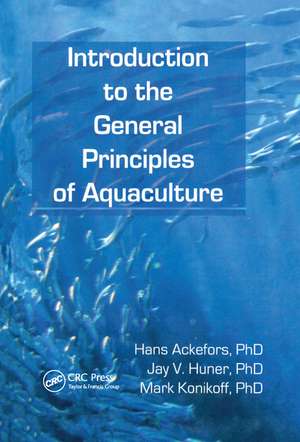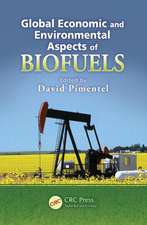Introduction to the General Principles of Aquaculture
Autor Hans Ackefors, Jay Huner, Mark Konikoffen Limba Engleză Paperback – 27 sep 2019
As an introductory text, it emphasizes several aspects of aquaculture that must be understood by those new to the industry. These aspects include water quality, species of importance around the world, and current and projected aquaculture production on a global basis. The important components of any aquaculture system are also covered in some detail--biological factors, technical-biological factors, technical-economic factors, production cost factors, socioeconomic factors, and species selection factors.
Laypersons considering aquaculture as an investment and students considering aquaculture as a career, but who have no real background in agriculture and fisheries sciences,will find this book to be a key information source. Introduction to the General Principles of Aquaculture is written with the global market in mind and instructors will find it to be a useful introductory text at the undergraduate level. Persons in advisory capacities such as County Extension Agents, extension service specialists and bureaucrats in various arms of government who hav
| Toate formatele și edițiile | Preț | Express |
|---|---|---|
| Paperback (1) | 368.31 lei 6-8 săpt. | |
| CRC Press – 27 sep 2019 | 368.31 lei 6-8 săpt. | |
| Hardback (1) | 484.16 lei 6-8 săpt. | |
| CRC Press – 21 noi 1994 | 484.16 lei 6-8 săpt. |
Preț: 368.31 lei
Preț vechi: 476.10 lei
-23% Nou
Puncte Express: 552
Preț estimativ în valută:
70.49€ • 72.81$ • 58.66£
70.49€ • 72.81$ • 58.66£
Carte tipărită la comandă
Livrare economică 25 martie-08 aprilie
Preluare comenzi: 021 569.72.76
Specificații
ISBN-13: 9780367401979
ISBN-10: 0367401975
Pagini: 172
Dimensiuni: 140 x 210 mm
Greutate: 0.35 kg
Ediția:1
Editura: CRC Press
Colecția CRC Press
ISBN-10: 0367401975
Pagini: 172
Dimensiuni: 140 x 210 mm
Greutate: 0.35 kg
Ediția:1
Editura: CRC Press
Colecția CRC Press
Public țintă
UndergraduateCuprins
Contents Introduction History and Development of Aquaculture Natural Production Versus Aquaculture The Environment for Aquatic Organisms Energy Use in Aquaculture Production Important Components of Aquaculture Factors Involved in the Selection of Species Suitable for Aquaculture Major Aquaculture Taxa and Their Geographical Importance Global Production of Aquaculture Products A Comparison of Aquaculture and Traditional Agriculture Factors Promoting and Constraining Aquaculture Conclusions and Prospects for Future Development Further Readings Glossary of Aquaculture Terms Index
Notă biografică
Ackefors, Hans; Huner, Jay; Konikoff, Mark
Descriere
Introduction to the General Principles of Aquaculture provides novice aquaculturists with an overview of the aquaculture industry so you may proceed successfully in academic studies or commercial ventures. The authors furnish you with insight into the history and development of aquaculture and cover the subjects of natural production versus aquaculture, the aquatic environment, energy requirements of and relationships in aquaculture systems, important components of aquaculture systems, selection of aquaculture species, major cultured species and their distribution, global aquaculture production, a comparison of agriculture and aquaculture, and those factors promoting and constraining aquaculture. The book is liberally illustrated so that students and laymen are able to visualize systems and species. Furthermore, tables and figures are used throughout to emphasize important points, facts, and methods.





